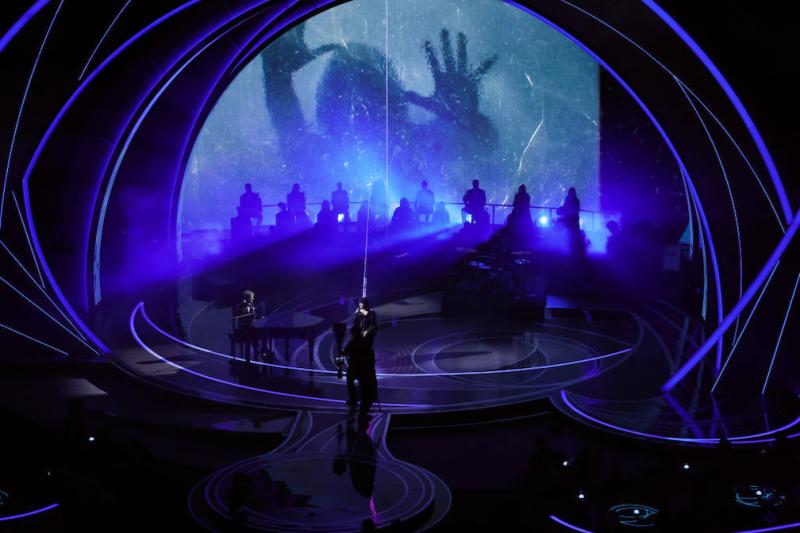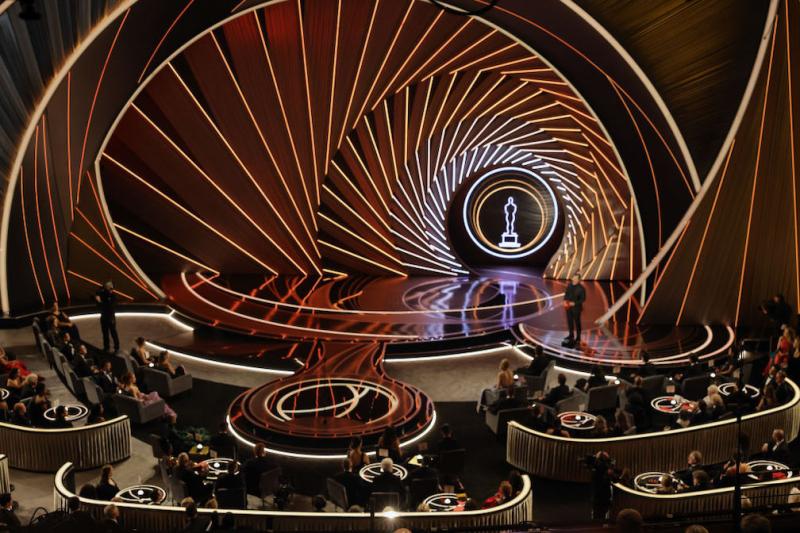The 94th Academy Awards. Certainly a night to remember. Scenic designer David Korins created a glamorous set, beautifully illuminated by the team from Full Flood, with lighting designers Bob Dickinson and Noah Mitz taking the lead along with lighting director Mike Berger. After a very scaled-back version of the Oscars in 2021, the show was back on stage at The Dolby Theatre in Hollywood on Sunday, March 27, 2022 and broadcast live by ABC. With chairs and tables on platforms built by All Access covering the first rows of chair in the auditorium, there was a supper-club look to the event. Live Design checks in with the lighting team to see what else was new this year.
Live Design: In addition to the Vari-Lites, what new fixtures were chosen this year, where placed and to what purpose?
Mike Berger: We took a big jump this year in replacing our “1st Electric” with automated fixtures. Traditionally filled with about 50 ETC Source Four ellipsoidals, we were able to swap to half as many Ayrton Diablos. These were an incredible time saver and also allowed us to maintain color temperature as we dimmed down intensities.
This year was huge for LED tape, utilizing over a mile of SBS RGBW 72 tape. Four scene shops across the country all worked together to make sure we had consistent product across the entire set. It was masterfully programmed by one of our lighting directors, Andy O’Reilly. In collaborating with Andy on the overhead rig, we made a decision to replace the wash lights with a second set of profiles, in this instance more Ayrton Diablos. More framing fixtures gave him the ability to precisely cut into the myriad of scenery onstage.
With the new, we also looked towards the old to help fill specific niches in the design. With the floor of The Dolby being raised so much, our normal audience lighting treatment needed to be re-worked. Approximately 100 Par 20 Birdies helped get soft sidelight into the near shots along the extremes of the room. They had the added benefit of looking great on camera in the cross shots.

LD: In terms of new technologies, what did you incorporate into the show?
MB: We used a lot more wireless this year, both RC4 and CRMX technologies. With the integration of so much RGBW tape, even into the smallest pieces of onstage scenery, we strove to keep as many cables as possible from crossing the stage floor. RC4 and battery packs got the Lucite and ribbon Oscars powered up while the Astera Ax3s on all the nominee tables helped to keep cable runs down in the house.
Full gear list and credits for the 2022 Oscars
LD: How long is the load-in and tech period?
MB: Scenery for the show starts loading in about a month beforehand, lighting comes in two weeks later. We have about four days to get the rig up and running before rehearsals take over. The first few days of rehearsal involve placing the scenic elements for camera and working on the screen content to match. All the while, Jeff Behm and Patrick Boozer, and the electricians are working meticulously away at the audience focus. In the last week of the show we have another four days of camera blocking followed by two dress rehearsals and the show. After a dark day, the entire show is out by the following Friday.
Light Plots For The 94th Academy Awards
LD: Can you talk about collaborating with David Korins on lighting vis-à-vis the set?
Bob Dickinson: David is an amazing collaborator. His theatrical background makes him well-suited for a production in a legit house such as The Dolby. Together with Raj Kapoor. who designed screen content, we began work on this months ago designing “virtual scenery” to extend and compliment the actual 3-D counterparts. A particular conceit that we suggested—and the producers liked—was making each hour of the three hour broadcast have it’s own color signature. Hour one being red, two-blue, and three the golden hour. David also designed discreet scenery for each of these hours. Working with Raj we came up with screen content that was intended never to look like screens, but rather real scenery with the associated lighting that I might apply should it have been actual scenic elements. This approach created depth and scenic environments that even the Oscars would have struggled to afford. As the actual scenery was developed David and his team worked closely with us on finishes and embedded LED technology. Because of the hybrid real scenery married to virtual scenery, the on site load in and cueing was doable given our schedule, that was indeed already generous to begin with. Not once did the screens change content on camera to ensure the illusion that it was actual scenery. Raj and his team created "screen lighting cues” to reflect those that I was building for the show.

LD: Can you tall about coordination with the screens/video content folks?
BD: Always a challenge, but through the aforementioned approach, we were never working on parallel creative approaches, it was merged into a single approach. Raj also designed the graphics for the show that reflected the scenic and color for each hour. Seamless.
LD: What was the artistic look of the lighting this year.. did the platforms and tables change the dynamic…
BD: We used very little smoke as this was an environment with a lot of visual density. In short we were not trying to fill voids with shafts of light.. The three of us agreed that we should never distract from the content with over the top screens/scenic/lighting. We wanted to reflect the event, not override it. The groovy main audience area was unorthodox, which created unusual camera coverage, which in turn created an almost impossible audience light circumstance. These are movie stars who want to look just like that…..glamorous and attractive. On many shows high contrast lighting is appropriate, but not the Oscars.
LD: Audience lighting?
BD: Jeff Behm and Patrick Boozer are the unsung heroes of this broadcast. They spent a week hanging, rehanging, and hanging fixtures. Then the focus that went on almost until we went on the air. The director would find a new and impossible angle for us to light and those two found ways to bathe it with the necessary lumens. We had to hemorrhage light into the nominee areas to cover the radical angles that Glenn Weiss the director resorted to. This was not a typical theatrical orchestra area with all the faces looking in the same direction, chairs were at various angles. In this audience, there was no clear upstage/downstage.
LD: Can you explain more about the choice to have a different color scheme each hour.. the red, blue and gold?
BD: It was a way to define the progression of the broadcast. We chose red because it was bold and we felt was stimulating. Blue for hour two because of the use of Swarovski Crystals and gold because the most important awards are toward the end and after all what color is Oscar? Of course we mixed in appropriate shades of white to compliment the color signatures.
LD: Can you talk about the lighting for the musical numbers.. especially Billie Eilish?
BD: As always, the music is the most fun for the lighting. The color bombast of "We Don't Talk About Bruno" was the anthesis of Billie. Reba of course is an amazing singer who looks like she did 30 years ago, but deserves the most flattering we can offer. Billie on the other hand brings a brooding mystic to the stage which I felt was best reflected by high-contrast key light that was uncorrected. The colorful liveliness of "Bruno" with some forty dancers challenged us as it used the entire ground floor of the theater as well as the stage. I felt secondary colors were best suited for the Latin beats.
LD: Any particular challenges this year?
BD: The show was unfortunately challenged by a certain event that occurred in the last hour. I felt that we delivered a virtually flawless production that was frankly one of the best looking award shows I have done, but the next day the press and even peers, friends and family all wanted the scoop on a single event. Sigh.
This show would never happen if it were not for the lighting director Mike Berger, who is the glue that holds it all together, he is the unsung hero. Finally it is really Noah Mitz as lighting designer who’s aesthetic collaboration is imperative. I am proud of the ultimate product we achieve together.